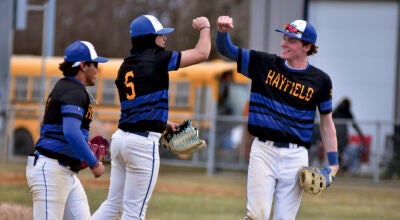Riege: Looking for walleyes in the night
Published 6:09 pm Wednesday, July 30, 2014
By Bob & Ginny Riege
When night fishing you have to do your homework during the day looking for three types of structure to locate fish. I look for the “typical walleye structure,” this is comprised of drop-offs, rock formations, points, or inside turns. The shallow structure that is usually found out in the middle of the lake. These types of structures might be classified as mid-lake humps, rock piles, reefs and sunken islands. The structure that I love to fish are weeds and wood. This type of structure might be classified as more bass or northern pike structure, but a lot of walleyes hang out in heavy weeds and wood throughout the year.
If the walleye is put in the lake as a fry it becomes a prey and naturally will find a place to hide. When the walleye grows up it becomes a predator and instinctively knows that the weeds are a place to look for prey.
A basic familiarity with the lake and the structures of the lake you’re planning to fish at night is important. Looking over your map will give you a chance to discover where these fish might be and shallow water obstructions.
When I first get on a heavily fished body of water, I’ll start running the lake and looking for things that aren’t obvious to all anglers. You might run a straight shoreline break and see where it changes from sand into rock or mud into hard bottom. You may even discover a rock pile that doesn’t show up on a lake map. With a depthfinder I can find those areas quickly. While night fishing I can use the plotter screen to move over the tops of these structures and dial in where my boat position is in relation to the specific structure.
Maybe I’ll find weed-oriented walleyes, and I may look for little breaks in the weed line rather than big elongated points off shore. I’ll run a straight break and suddenly I might see a little inside turn or little turning point down the weed line. Another gold mine is small gravel patches near or within a weedline.
One of my favorite spots to look for nighttime walleye is near the entrances of a bay or harbor, especially if the entrance is narrow and there are at least seven to ten feet of water nearby.
The key to a productive area is the presence of baitfish such as shiners. If minnows are in the harbor or the bay during the day, walleyes will visit at night. Check the area to be fished and see if there is an abundance of bait.
It might take a while to get these fish figured out, but once the best fishing time is established, the fish will feed at that time, or close to it, the next few nights. A change in weather can throw off this timing.
On snag-free bottoms a Lindy Rig is effective. On mud, weeds, submerged timber and rocks or boulders, a Lindy No-Snagg slip sinker attached to the Lindy Rig will keep you catching fish and not snags. This slower presentation gets most of the action especially in shallow water. Early, late and at night faster-moving lures such as a No. 5 or No. 7 Shad Rap really perk things up. That’s when I particularly like to cast an artificial minnow into the shallows.
Walleyes can cruise in amazingly shallow waters after dark. I’ve taken them in no more than a foot of water many times at night. Wading is sometimes easier than boat fishing, but summer walleyes are easily spooked and must be fished from a distance.
The long line trolling reduces feel but allows time for the boat to pass overhead and for the spooked walleyes to regroup. When the boat finally passes by the fish, they hit it with a subtle gentle tug, rather than smashing the bait.
Long-line trolling is a very effective method to use on walleyes. Not only can you use live bait, but crankbait fishing is very productive.
Trolling success usually depends on how well you fine-tune your presentation. Simple things that will help you trigger fish might be pumping your rod, or allowing your crankbait to stunt.
You should sweep your rod in a 30-degree arc with a pause at the end. The lure speeds up through the sweep and triggers the fish that there is an escaping prey. Most strikes might occur as the rod is returned to the original position.
The stunting that you might want to try is to use a deep lip crankbait like a deep diving Storm Thunder Stick and troll this in an area that has a soft bottom like mud or sand. The long bill will dive deep and stunt into the soft bottom. This will cause an erratic motion to the fish, plus stir up the bottom and fish will move in to investigate. The pause surge pause motion of your rod will encourage more strikes than just trolling with a dead rod.
If you happen to be on a weedy lake and the weeds are emerging try long-line trolling on top of the weeds with live bait on small lipless crankbaits, just ticking the weed tops.
If you try this approach it will most often produce more fish than the guy sitting and waiting for his bobber to go down. Allow yourself to experiment and use long-line trolling this with live bait or crankbaits summer to give you an edge.



